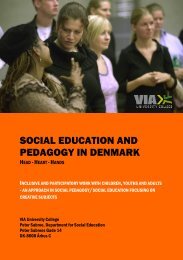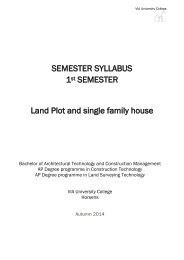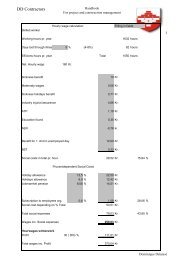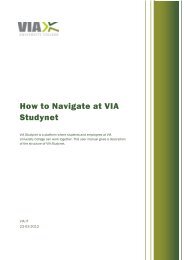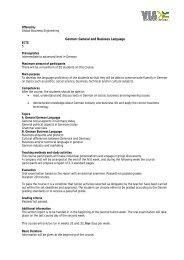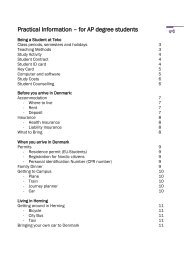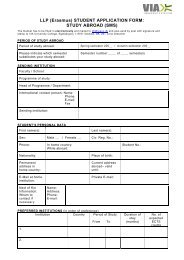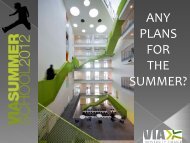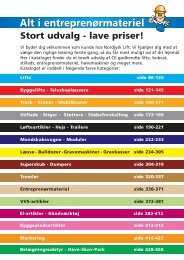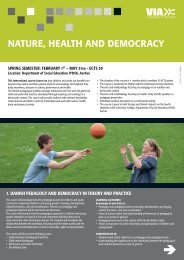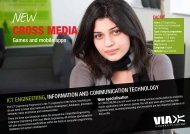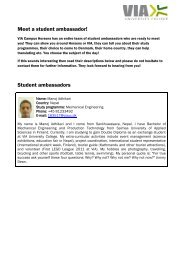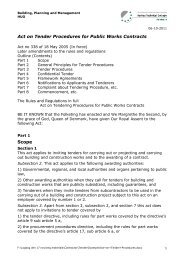Brochure (pdf) - VIA University College
Brochure (pdf) - VIA University College
Brochure (pdf) - VIA University College
You also want an ePaper? Increase the reach of your titles
YUMPU automatically turns print PDFs into web optimized ePapers that Google loves.
Animationas a Learning ToolInternational semester inanimation as a method of learningSpring Semester: Mid February – End June • 30 ECTS... and ...Autumn Semester: Mid August – December • 30 ECTSLocation: Department of Education and Social Studies • Viborg<strong>VIA</strong> <strong>University</strong> <strong>College</strong> • Education and Social StudiesCampus Viborg • Prinsens Allé 2 • DK-8800 Viborg • DenmarkTel. +45 87 55 37 00 • Fax +45 87 55 37 01viborg.international@viauc.dk • www.viauc.com
Animationas a Learning ToolInternational semester inanimation as a method of learningSpring Semester: Mid february – End June • 30 ECTS... and ...Autumn Semester: Mid August – December • 30 ECTSLocation: Department of Education and Social Studies • ViborgAnimation as a Learning ToolChildhood has changed rapidly over the past few years – and the methods that we use as teachers andeducators of children and young people should reflect these changes.Children learn best and most when they enjoy what they are doing. Using animation as a tool toencourage and develop children’s learning is not only fun but effective! By using animation childrendevelop skills and competencies in:• Story telling• Visual communication• Cognition, emotional, ethic and aesthetic aspects• Observation and sensory aspects• Concentration• Problem-solving and innovative aspectsThe module is designed for students who wish to study in Denmark and use animation as a pedagogicaltool in their professional work with children and young people.2
Aims of the module• To explore the possibilities of animation as a method of learning to develop children’s and youngpeople’s skills and competencies• To acquire skills in using ICT/multimedia in pedagogical learning• To develop an understanding of aesthetic, alternative and inclusive learning methods and didactics• To learn to work in groups and develop personal and professional skills in cooperation• To acquire basic animation skills and learn the processes behind an animated film• To obtain experience in the pedagogical uses of animation through fieldwork – observations, interviews,data collection and analysis• To widen the theoretical knowledge of educational and learning approachesThe module is designedfor students who wish tostudy in Denmark and useanimation as a pedagogicaltool in their professionalwork with children andyoung people3
The module will include the following learning aspectsIntroduction• The Danish welfare system• Education in the Scandinavian context• Visiting day care institutions and schools• Danish art and culture• Danish language courseAnimationIntroduction to different animation techniques(all subjects are basic at beginner’s level) :• Pixilation• Claymation• Cutout• Drawn animation• Visual Communication• Composition• Backgrounds• Character design• Storyboard• Storytelling• Film language• Sound• Film analysis• Nonverbal communicationLanguage development• Language acquisition – an overview• Children’s use of language• Language and aesthetic learning processes• Child culture and play culture• Language and narrativesLearning and working together• Learning theories• Aesthetic learning processes• Learning in groups• The role of the teacher• Inclusion and education• Didactic theoryField work• Working with children and young people• Animation as a learning tool• Didactics in practice• Reflecting theory and practice• Observations of individual and social learningprocessesThe above written subjects are taught throughpractical work:The students will work in different groupsand produce approx. 4 short films, based onassignments given on all the above writtensubjects.At the end of the semester each student willproduce a final film and a written portfolio,describing the work process of the final film.4
During a two week fieldwork at a Danish school/kindergarten, the student will help/guide thechildren produce short animations.Field work is completed with a written reportfocusing on learning processes, didactics and thelanguage development of children.The practical experience of the field work and thetheoretical elements are analyzed in the report,which also includes reflections on Animation as aLearning Tool.Evening classes:• Basic introduction to classical life drawing• Film nights:Various animated short and long films5
Learning outcomesStudents will have acquired:• Basic knowledge of how to produce an animated film using different techniques, such asclaymation, cutout and pixilation• Knowledge of how to use metaphors, symbols and contrasts in animation and how to stimulatechildren´s development and learning• Improved skills in using basic computer software and different animation techniques, as a methodto develop children’s language competencies• Basic knowledge of film language, composition, backgrounds and character design• Awareness of language development through aesthetic learning processes and how these relateto other learning processes• Understanding of the processes related to animation and how these stimulate children´scognitive, social, emotional and motor development• Educational tools to use in inclusive teaching• Explore the possibilities of using Animation as a Learning Tool in a pedagogical context• Ability to work collaboratively in group-based activities• The module content is balanced between theoretical studies and practical activities, so studentswill experience not only the WHY of learning, but also the HOWAssessmentThe students are assessed through the submission of a written report that illustrates their theoreticalreflections and understandings of the pedagogical possibilities of offering children the opportunityto produce animated cartoons and a short animation film and portfolio.All students who complete the module will receive a Diploma and a detailed Transcript of Recordswith specification of the 30 ECTS.6
Animation as a Learning Tool • 5th Semester • 30 ECTS creditsThe fifth semester on the Bachelor Programme in Social Education, Viborg, is offered in English with thetitle ”Animation as a Learning Tool”. The semester will be conducted in accordance with the curriculum of1. September 2009 and in cooperation with The Animation Workshop.The aim is for the student to acquire knowledge, skills and competencies in expressing herself/himselfusing various animation forms as well as insight into and an understanding of how to apply animation asa learning tool towards children and young people.Subject ECTS credits Comments on the subjectThe specialisationChildren and Young People– including:Social Education7 ECTSExpression, Music and Drama 4 ECTSand Specialisation1 ECTS12PedagogyKnowledge about the living conditionsand well-being of children and youngpeople in relation to cultural, institutionaland social conditions – including:Didactics• Establish professionally well-foundedaims and possibilities for action inanimation as a learning tool• Implement and evaluate socialeducation courses with children andyoung peopleLearning• Learning theory• Aesthetic learningDanish (language),Culture and Communication 9Expression, Music and Drama 9Knowledge about the development ofchildren and how animation techniquesmay support the development of languageand concepts – including:• Language and identity• Media theory and genre• Analysis, interpretation, assessment andproduction of animation films• Story-telling and narrativity• StoryboardKnowledge of art and cultural forms ofexpression as well as insight into Danishart and cultureKnowledge and skills in production ofdifferent animation forms/techniquesUnderstanding of different animationtechniques and genres including theirapplication within social educationSkills in analysing and explaining thechoice of visual effects in animation filmsKnowledge about the sensual, emotional,physical and intellectual aspects of theforms of expression7
Fees and HousingThere is no tuition fee for Erasmus bilateral partners of<strong>VIA</strong> <strong>University</strong> <strong>College</strong>.There is at tuition fee for students from institutions withouta bilateral partner agreement.<strong>VIA</strong> <strong>University</strong> <strong>College</strong> can offer accommodation withinwalking distance from Campus Viborg.The monthly rent per student is approximately Euro 250.Please note that the monthly rent may be subject tochange.ApplicationThe student application/housing form and information ofdeadline for application at www.viauc.com or emailbvh@viauc.dkAcademic QuestionsModule CoordinatorAnnette Husum Jensenahuj@viauc.dkPhone +45 87 55 37 22Application and HousingInternational Project CoordinatorBirgitte Vigsø henningsenbvh@viauc.dkPhone +45 8755 37 36More information on our beautiful city Viborgis available online atwww.viborg.dk/english<strong>VIA</strong> PSH · ordrenr. 04296 · marts 2013 · lip



